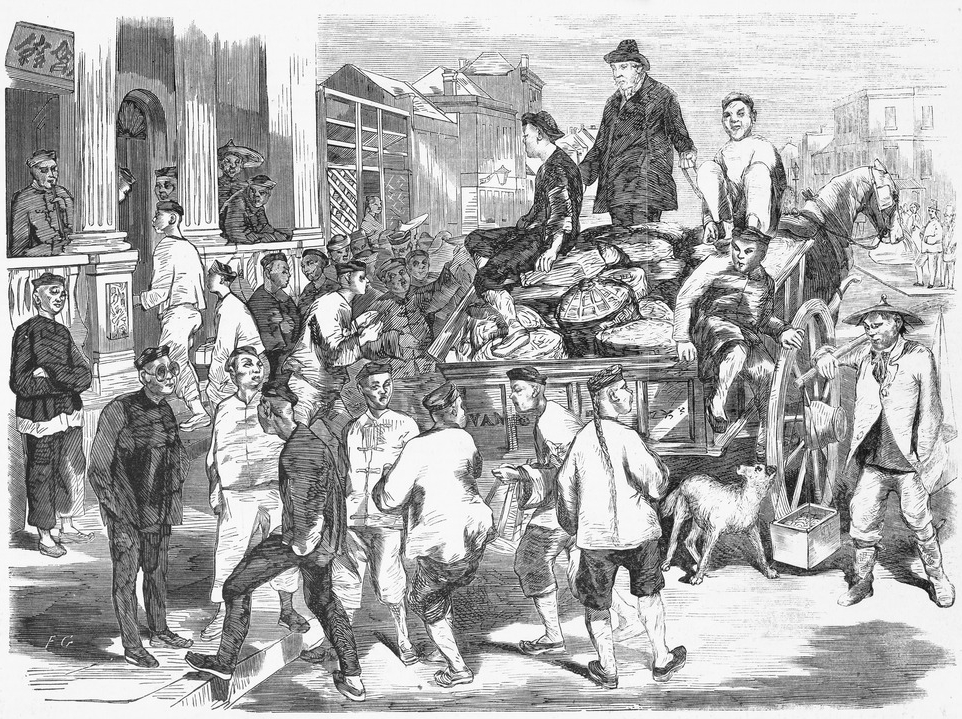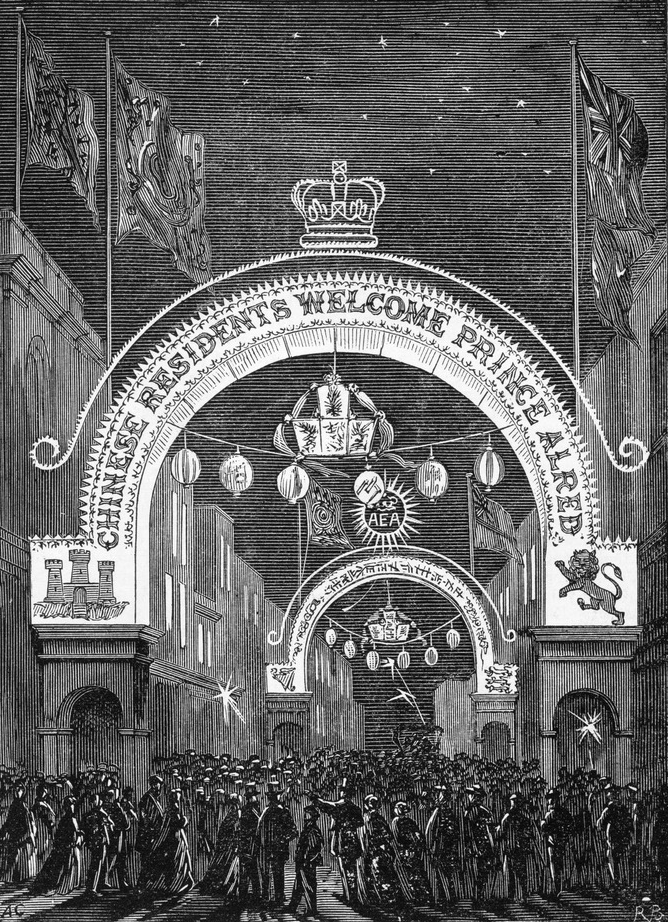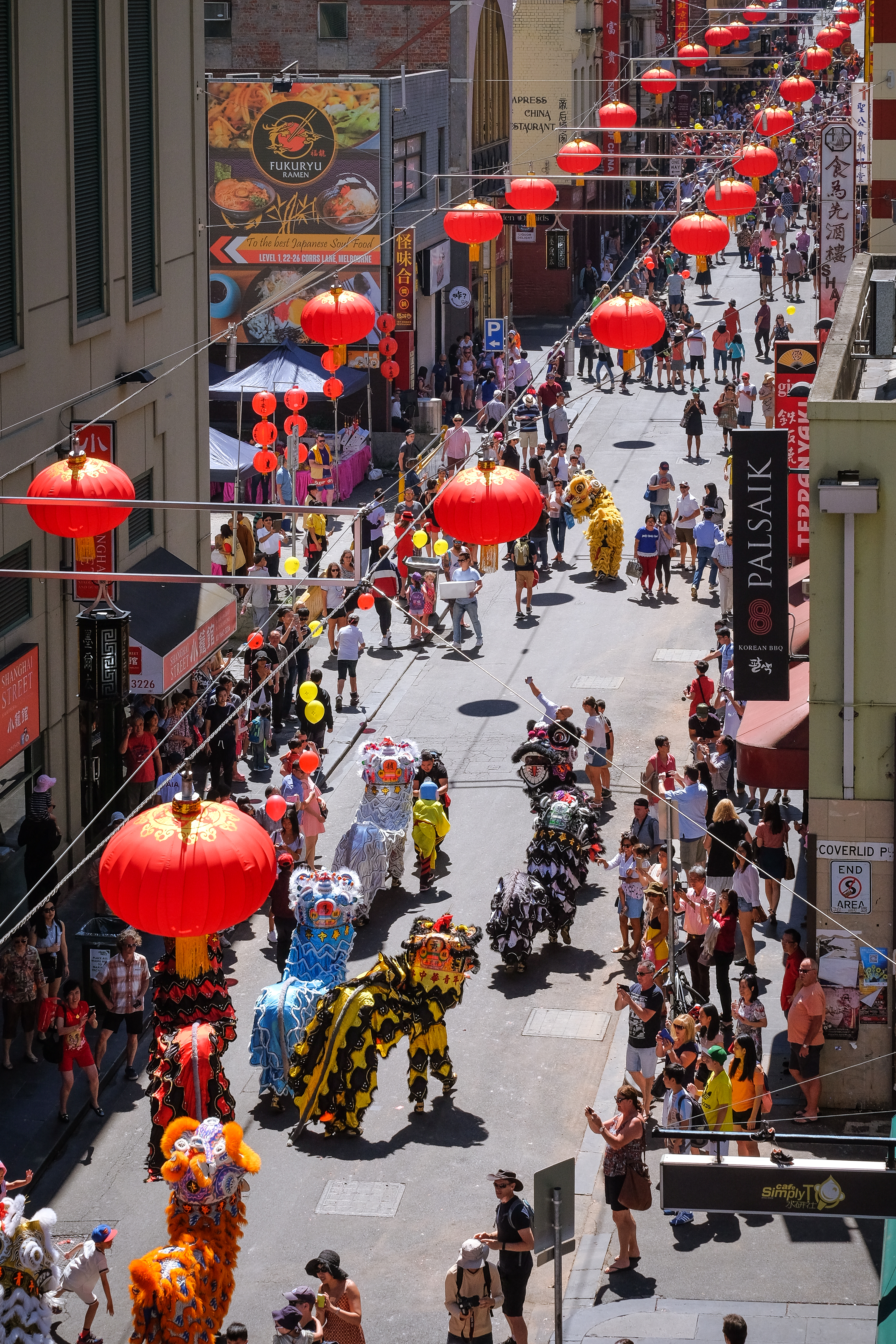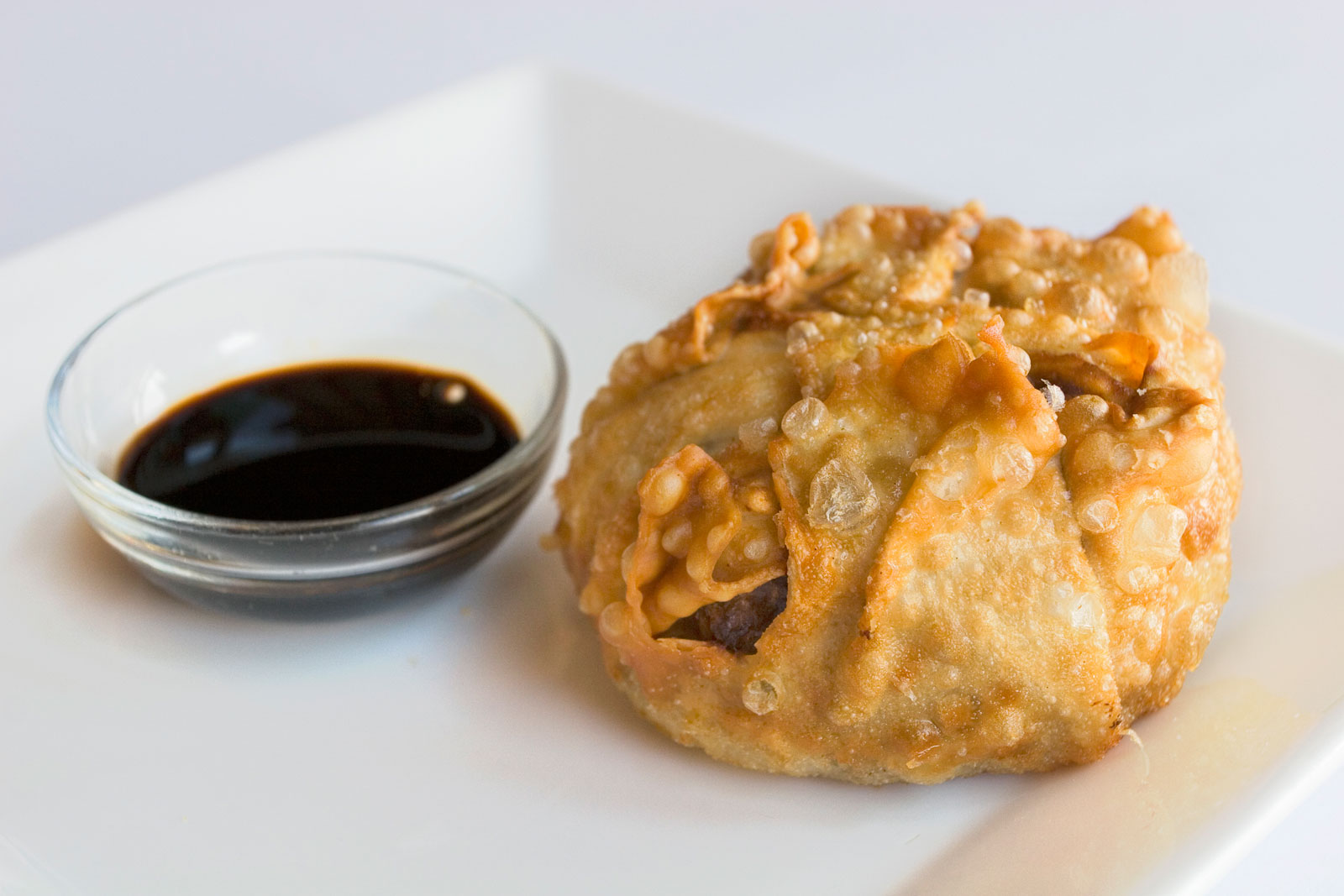Chinatown, Melbourne on:
[Wikipedia]
[Google]
[Amazon]

 Chinatown () is an
Chinatown () is an
 The advent of the
The advent of the  The residents of Chinatown established themselves as storekeepers, importers, furniture-makers, herbalists and in the wholesale fruit and vegetable industries, with a strong presence at the nearby Eastern Market on Bourke Street. Christian churches were built and Chinese political groups and newspapers were subsequently formed. Other members of the Chinese community who lived and worked elsewhere used Chinatown to congregate with friends. The area also provided further support to new Chinese immigrants.
Early in its history, Chinatown developed a reputation for "salubrious" enterprises including opium dens, gambling houses and brothels, but maintained a distinctly "entrepreneurial air". By 1859, Victoria's Chinese population reached approximately 45,000, representing nearly 8.5% of the colony's total population.
Australian colonial author
The residents of Chinatown established themselves as storekeepers, importers, furniture-makers, herbalists and in the wholesale fruit and vegetable industries, with a strong presence at the nearby Eastern Market on Bourke Street. Christian churches were built and Chinese political groups and newspapers were subsequently formed. Other members of the Chinese community who lived and worked elsewhere used Chinatown to congregate with friends. The area also provided further support to new Chinese immigrants.
Early in its history, Chinatown developed a reputation for "salubrious" enterprises including opium dens, gambling houses and brothels, but maintained a distinctly "entrepreneurial air". By 1859, Victoria's Chinese population reached approximately 45,000, representing nearly 8.5% of the colony's total population.
Australian colonial author
 Chinatown peaked in the early 20th century in terms of population and size with businesses having expanded into the nearby Little Lon red-light district, transforming it into a predominantly Chinese-owned area. This growth was hampered by the Immigration Restriction Act, implemented after the
Chinatown peaked in the early 20th century in terms of population and size with businesses having expanded into the nearby Little Lon red-light district, transforming it into a predominantly Chinese-owned area. This growth was hampered by the Immigration Restriction Act, implemented after the  During the 1960s and 1970s, the White Australia policy was dismantled, resulting in a substantial increase in immigration from Indochina, Singapore, Malaysia, Taiwan, Hong Kong and the People's Republic of China. The demographics of Chinatown, as well as its culinary scene, greatly diversified as a result.
In 2010, the ground floor of the Chinese Museum was remodelled as a visitor centre for Melbourne's Chinatown. The following year, a memorial statue of Dr Sun Yat-sen was unveiled outside the museum's entrance, in celebration of the 100th anniversary of the founding of the
During the 1960s and 1970s, the White Australia policy was dismantled, resulting in a substantial increase in immigration from Indochina, Singapore, Malaysia, Taiwan, Hong Kong and the People's Republic of China. The demographics of Chinatown, as well as its culinary scene, greatly diversified as a result.
In 2010, the ground floor of the Chinese Museum was remodelled as a visitor centre for Melbourne's Chinatown. The following year, a memorial statue of Dr Sun Yat-sen was unveiled outside the museum's entrance, in celebration of the 100th anniversary of the founding of the
 The Asian food festival is typically held in Spring and celebrates
The Asian food festival is typically held in Spring and celebrates
Chinese Museum, Melbourne - www.joyofmuseums.com - exterior.jpg, Cohen Place
File:Chinese Arch Little Bourke St Melbourne.jpg, Russell Street
Image:Melbourne Chinatown Archway.jpg, Exhibition Street
File:Gate to Melbourne Chinatown.jpg,
File:Num Pon Soon Melbourne.jpg, The Num Pon Soon building, built in 1861
File:Sum Kum Lee Melbourne.jpg, The Sum Kum Lee building, built in 1887, currently tenanted by the dumpling house Shanghai Village
File:Chinese Museum, Melbourne - www.joyofmuseums.com - exterior 2.jpg, Chinese Museum, located in a converted warehouse, built in 1890
File:Gordon Apartments Little Bourke Street.jpg, Tenements, built in 1884
File:Dr. Sun Yat Sen Statue.jpg, Statue of Sun Yat-sen
File:Melbourne Tianjin Garden.jpg, The Tianjin Garden on Spring Street
File:Melbourne Croft Alley.jpg, Street art in Croft Alley
File:Corrs Lane Chinatown.jpg, Corrs Lane, the CBD's narrowest laneway
Chinese Museum
Museum of Chinese Australian History.
Chinatown Precinct Association website
{{Authority control Melbourne City Centre *

 Chinatown () is an
Chinatown () is an ethnic enclave
In sociology, an ethnic enclave is a geographic area with high ethnic concentration, characteristic cultural identity, and economic activity. The term is usually used to refer to either a residential area or a workspace with a high concentration ...
in the central business district
A central business district (CBD) is the Commerce, commercial and business center of a city. It contains commercial space and offices, and in larger cities will often be described as a financial district. Geographically, it often coincides wit ...
(CBD) of Melbourne
Melbourne ( , ; Boonwurrung language, Boonwurrung/ or ) is the List of Australian capital cities, capital and List of cities in Australia by population, most populous city of the States and territories of Australia, Australian state of Victori ...
, Victoria, Australia. Centred at the eastern end of Little Bourke Street, it extends between the corners of Swanston and Spring streets, and consists of numerous laneways, alleys and arcades. Established in the 1850s during the Victorian gold rush
The Victorian gold rush was a period in the history of Victoria, Australia, approximately between 1851 and the late 1860s. It led to a period of extreme prosperity for the Australian colony and an influx of population growth and financial capi ...
, it is notable for being the longest continuous ethnic Chinese settlement in the Western World
The Western world, also known as the West, primarily refers to various nations and state (polity), states in Western Europe, Northern America, and Australasia; with some debate as to whether those in Eastern Europe and Latin America also const ...
and the oldest Chinatown in the Southern Hemisphere.
Melbourne's Chinatown has played an important role in establishing the culture of Chinese immigrants in Australia, and is still home to many Chinese restaurants, cultural venues, businesses and places of worship. Today, Melbourne's Chinatown is a major tourist attraction
A tourist attraction is a place of interest that tourists visit, typically for its inherent or exhibited natural or cultural value, historical significance, natural or built beauty, offering leisure and amusement.
Types
Places of natural beaut ...
, known for its architectural heritage, annual festivals and cuisines of Asian origins, as well as its karaoke venues, bars and fashion boutiques.
Beyond Chinatown and the CBD, Melbourne's Chinese community is well-represented in other areas of the city, most notably Box Hill, where a $450 million development named "New Chinatown" is currently being constructed.
Chinatown is home to the Chinese Museum.
History
Gold rush beginnings and colonial era (1850s–1890s)
 The advent of the
The advent of the Victorian gold rush
The Victorian gold rush was a period in the history of Victoria, Australia, approximately between 1851 and the late 1860s. It led to a period of extreme prosperity for the Australian colony and an influx of population growth and financial capi ...
in 1851 attracted immigrants from around the world, including tens of thousands of Chinese prospectors
Prospecting is the first stage of the geological analysis (followed by exploration) of a territory. It is the search for minerals, fossils, precious metals, or mineral specimens. It is also known as fossicking.
Traditionally prospecting rel ...
. The majority were Cantonese-speaking male villagers from Hong Kong
Hong Kong)., Legally Hong Kong, China in international treaties and organizations. is a special administrative region of China. With 7.5 million residents in a territory, Hong Kong is the fourth most densely populated region in the wor ...
and nearby areas, including the southwestern districts of Guangdong
) means "wide" or "vast", and has been associated with the region since the creation of Guang Prefecture in AD 226. The name "''Guang''" ultimately came from Guangxin ( zh, labels=no, first=t, t= , s=广信), an outpost established in Han dynasty ...
(See Yup), and its capital city Guangzhou
Guangzhou, Chinese postal romanization, previously romanized as Canton or Kwangchow, is the Capital city, capital and largest city of Guangdong Provinces of China, province in South China, southern China. Located on the Pearl River about nor ...
(Sam Yap). The eastern half of Little Bourke Street was considered convenient for these immigrants, as both a staging post and a place to pick up supplies en route to the goldfields in central Victoria. The earliest lodging houses were established in Celestial Avenue, off Little Bourke Street, and by 1855, Chinese houses and businesses lined the majority of Little Bourke Street from Elizabeth to Russell streets.
It is notable for being the oldest Chinatown in the Southern Hemisphere, and the longest continuous Chinese settlement outside Asia, owing to San Francisco
San Francisco, officially the City and County of San Francisco, is a commercial, Financial District, San Francisco, financial, and Culture of San Francisco, cultural center of Northern California. With a population of 827,526 residents as of ...
's Chinatown
Chinatown ( zh, t=唐人街) is the catch-all name for an ethnic enclave of Chinese people located outside Greater China, most often in an urban setting. Areas known as "Chinatown" exist throughout the world, including Europe, Asia, Africa, O ...
's relocation following the 1906 earthquake. The Victorian gold rush eventually waned, causing a shift from rural living and an influx of people migrating into metropolitan Melbourne, particularly Little Bourke Street, which already had a predominantly Chinese population.
 The residents of Chinatown established themselves as storekeepers, importers, furniture-makers, herbalists and in the wholesale fruit and vegetable industries, with a strong presence at the nearby Eastern Market on Bourke Street. Christian churches were built and Chinese political groups and newspapers were subsequently formed. Other members of the Chinese community who lived and worked elsewhere used Chinatown to congregate with friends. The area also provided further support to new Chinese immigrants.
Early in its history, Chinatown developed a reputation for "salubrious" enterprises including opium dens, gambling houses and brothels, but maintained a distinctly "entrepreneurial air". By 1859, Victoria's Chinese population reached approximately 45,000, representing nearly 8.5% of the colony's total population.
Australian colonial author
The residents of Chinatown established themselves as storekeepers, importers, furniture-makers, herbalists and in the wholesale fruit and vegetable industries, with a strong presence at the nearby Eastern Market on Bourke Street. Christian churches were built and Chinese political groups and newspapers were subsequently formed. Other members of the Chinese community who lived and worked elsewhere used Chinatown to congregate with friends. The area also provided further support to new Chinese immigrants.
Early in its history, Chinatown developed a reputation for "salubrious" enterprises including opium dens, gambling houses and brothels, but maintained a distinctly "entrepreneurial air". By 1859, Victoria's Chinese population reached approximately 45,000, representing nearly 8.5% of the colony's total population.
Australian colonial author Marcus Clarke
Marcus Andrew Hislop Clarke (24 April 1846 – 2 August 1881) was an English-born Australian novelist, journalist, poet, editor, librarian, and playwright. He is best known for his 1874 novel ''For the Term of His Natural Life'', about the con ...
wrote in 1868:
Despite the cultural divide, several community leaders with strong Chinatown connections became influential and well-regarded among Melburnians more broadly, including businessman Lowe Kong Meng, police detective Fook Shing and missionary Cheok Hong Cheong. Also during the colonial period, a number of businesses run by Australians of European descent were based in Chinatown, including the offices of '' Table Talk'', one of Melbourne's most popular magazines in the 1880s.
Federation, population decline and revival (1901–present day)
 Chinatown peaked in the early 20th century in terms of population and size with businesses having expanded into the nearby Little Lon red-light district, transforming it into a predominantly Chinese-owned area. This growth was hampered by the Immigration Restriction Act, implemented after the
Chinatown peaked in the early 20th century in terms of population and size with businesses having expanded into the nearby Little Lon red-light district, transforming it into a predominantly Chinese-owned area. This growth was hampered by the Immigration Restriction Act, implemented after the federation of Australia
The Federation of Australia was the process by which the six separate British self-governing colonies of Queensland, New South Wales, Victoria, Tasmania, South Australia (which also governed what is now the Northern Territory), and Wester ...
in 1901. Chinatown's subsequent decline was further exacerbated by a broader shift of businesses and residents from Melbourne's central business district (CBD) to the surrounding suburbs.
In the 1920s, more Australians of European descent began frequenting Chinatown eateries, one being Chung Wah on Heffernan Lane, a haven for members of the University of Melbourne ALP Club. This growing patronage helped pave the way for a distinctly Australian Chinese cuisine
Australian Chinese cuisine is a style of cooking developed by Chinese Australians, Australians of Chinese descent, who adapted dishes to satisfy local Anglo-Celtic tastes. Its roots can be traced to indentured Chinese who were brought to work as ...
, which achieved mainstream popularity by the mid-20th century. The dim sim, a staple of Australian Chinese cuisine, was invented in Chinatown by William Wing Young, in 1945, at his restaurant Wing Lee, and has become a major snack food in takeaway outlets and supermarkets throughout the country. Young's daughter, Elizabeth Chong, became a television celebrity chef and Chinatown tour guide. Chinatown's potential as a tourist site was recognised in the 1960s by local entrepreneur and politician David Wang, whose push for the redevelopment of Little Bourke Street led to the archways of today.
 During the 1960s and 1970s, the White Australia policy was dismantled, resulting in a substantial increase in immigration from Indochina, Singapore, Malaysia, Taiwan, Hong Kong and the People's Republic of China. The demographics of Chinatown, as well as its culinary scene, greatly diversified as a result.
In 2010, the ground floor of the Chinese Museum was remodelled as a visitor centre for Melbourne's Chinatown. The following year, a memorial statue of Dr Sun Yat-sen was unveiled outside the museum's entrance, in celebration of the 100th anniversary of the founding of the
During the 1960s and 1970s, the White Australia policy was dismantled, resulting in a substantial increase in immigration from Indochina, Singapore, Malaysia, Taiwan, Hong Kong and the People's Republic of China. The demographics of Chinatown, as well as its culinary scene, greatly diversified as a result.
In 2010, the ground floor of the Chinese Museum was remodelled as a visitor centre for Melbourne's Chinatown. The following year, a memorial statue of Dr Sun Yat-sen was unveiled outside the museum's entrance, in celebration of the 100th anniversary of the founding of the Republic of China
Taiwan, officially the Republic of China (ROC), is a country in East Asia. The main geography of Taiwan, island of Taiwan, also known as ''Formosa'', lies between the East China Sea, East and South China Seas in the northwestern Pacific Ocea ...
. The traditional Chinese New Year Lion Dance has always ended at this spot, but will now end with a blessing of the statue.
Culture
Chinese New Year
TheChinese New Year
Chinese New Year, or the Spring Festival (see also #Names, § Names), is a festival that celebrates the beginning of a New Year, new year on the traditional lunisolar calendar, lunisolar Chinese calendar. It is one of the most important holi ...
is primarily celebrated in Chinatown on the first Sunday of the new Lunar year. It is the original and primary location of Melbourne's CNY festival, although the festival has expanded to multiple CBD sites in recent years, including Crown Casino. The celebrations feature traditional and contemporary Chinese cultural activities and festivities, dances, Chinese opera and singing, karaoke competition, numerous stalls of culinary delights, arts and crafts, Chinese chess competitions, calligraphy and children's events.
The Dai Loong Dragon Parade, as well as the main Lion Dances (performed by the Chinese Youth Society of Melbourne, Chinese Masonic Society and Hung Gar Martial Arts School) begin at roughly 10am on the Sunday following New Year, and run till roughly 4pm. The Dragon parade begins and ends at Melbourne's Chinese Museum.
Asian Food Festival
 The Asian food festival is typically held in Spring and celebrates
The Asian food festival is typically held in Spring and celebrates Asian cuisine
Asian cuisine encompasses several significant regional cooking styles of Asia: Central Asian, East Asian, North Asian, South Asian, Southeast Asian, and West Asian. Cuisine is a distinctive way of cooking practices and customs, usually associat ...
with food tasting, stalls, cooking demonstrations, among others.
Other Chinese communities
Beyond the original Chinatown in the CBD, several newer Chinese communities have developed in Melbourne's eastern suburbs, such as Box Hill, Glen Waverley and Springvale. An older community, with links back to the 1850s gold rush, is to be found in the regional city ofBendigo
Bendigo ( ) is an Australian city in north-central Victoria. The city is located in the Bendigo Valley near the geographical centre of the state and approximately north-west of Melbourne, the state capital.
As of 2022, Bendigo has a popula ...
, 150 km north-west of Melbourne.
Cultural depictions
Tom Roberts
Thomas William Roberts (8 March 185614 September 1931) was an English-born Australian artist and a key member of the Heidelberg School art movement, also known as Australian impressionism.
After studying in Melbourne, he travelled to Europe i ...
, one of the leading figures of Australian Impressionism, created sketches of life in Little Bourke Street in the 1880s. During the Second World War, modernist Eric Thake created a series of works depicting Chinatown shopfronts, which now belong in the State Library of Victoria
State Library Victoria (SLV) is the state library of Victoria, Australia. Located in Melbourne, it was established in 1854 as the Melbourne Public Library, making it Australia's oldest public library and one of the first free libraries in th ...
's painting collection.
Fergus Hume's '' The Mystery of a Hansom Cab'' (1886), one of the most famous mystery crime novels of the Victorian era, is based largely on the author's observations of life in Little Bourke Street, including the "dark recesses" of the Chinese Quarter, where Detective Kilsip, the novel's protagonist, pursues his suspect. Alfred Dampier
Alfred Dampier (28 February 1843? 1847? – 23 May 1908) was an English-born actor-manager
and playwright, active in Australia.John Rickard,Dampier, Alfred (1843–1908), ''Australian Dictionary of Biography'', Vol. 4, Melbourne University Pre ...
's ''Marvellous Melbourne'' play of the same year features a scene in a Chinatown opium den.
Between 1909 and 1910, Melbourne's first Chinese-language newspaper, the '' Chinese Times'', serialised Wong Shee Ping's novel '' The Poison of Polygamy'', the first novel written in Literary Chinese
Classical Chinese is the language in which the classics of Chinese literature were written, from . For millennia thereafter, the written Chinese used in these works was imitated and iterated upon by scholars in a form now called Literary ...
to be published in Australia and possibly the West. Set in Victoria during the 1850s gold rush, the novel describes life in Chinatown.
Set in Little Bourke Street, Elinor Mordaunt's 1919 novel ''The Ginger Jar'' is about a love affair between a Chinese Australian hawker and a European woman.
A pivotal scene of the 1911 silent film '' The Double Event'', directed by W. J. Lincoln, takes place in Melbourne's Chinatown.
The 1997 Hong Kong action film
Hong Kong action cinema is the principal source of the Hong Kong film industry's global fame. Action films from Hong Kong have roots in Chinese culture, Chinese and Culture of Hong Kong, Hong Kong cultures, including Chinese opera, storytelling a ...
'' Mr. Nice Guy'', starring Jackie Chan
Fang Shilong (born Chan Kong-sang; 7 April 1954), known professionally as Jackie Chan,; is a Hong Kong actor and filmmaker, known for his slapstick, acrobatic fighting style, comic timing, and innovative stunts, which he typically perf ...
, is set in Melbourne, with several scenes shot in Chinatown.
Chinatown appears in episodes of the period detective drama series ''Miss Fisher's Murder Mysteries
''Miss Fisher's Murder Mysteries'' is an Australian detective television series. It was first broadcast on ABC on 24 February 2012. It is based on author Kerry Greenwood's historical mystery novels, and it was created by Deb Cox and Fiona Ea ...
'' (2012–2015), including "Ruddy Gore" (episode 6, season 1), which focuses largely on Chinatown and its connection to the East End Theatre District.
Gallery
Archways
Swanston Street
Swanston Street is a major thoroughfare in the Melbourne central business district, Victoria, Australia. It was laid out in 1837 as part of the original Hoddle Grid. The street vertically bisects Melbourne's city centre and is famous as the wor ...
Buildings
Other sites
See also
* Heavenly Queen Temple (Melbourne) * Chinese Museum, MelbourneReferences
Bibliography
Books * Journals Theses WebpagesExternal links
Chinese Museum
Museum of Chinese Australian History.
Chinatown Precinct Association website
{{Authority control Melbourne City Centre *
Melbourne
Melbourne ( , ; Boonwurrung language, Boonwurrung/ or ) is the List of Australian capital cities, capital and List of cities in Australia by population, most populous city of the States and territories of Australia, Australian state of Victori ...
Culture of Melbourne
Landmarks in Melbourne
1851 establishments in Australia
Tourist attractions in Melbourne